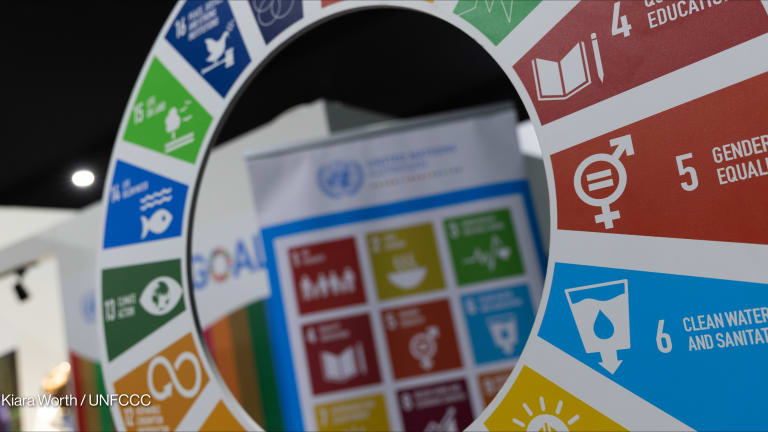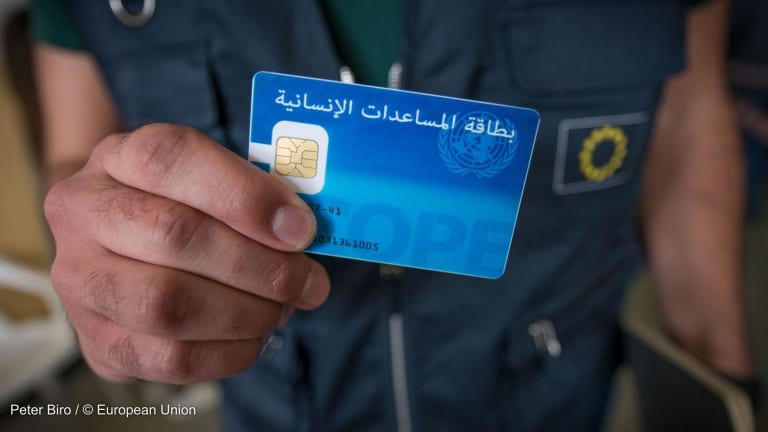Backpacks of cash: How to make payments when all the options are bad
Getting money into some of the world's most difficult crisis zones is no easy chore, but digital transfers offer a promising new route. Devex spoke to MasterCard and sQuid about the future of humanitarian payments.
When the development sector responds to a crisis, one of the first logistical challenges they encounter is also among the trickiest ones: how to move money where it’s needed. There is no easy way to getting the often millions of dollars needed into remote localities with no formal banking, far-flung refugee camps, or active disaster zones. The usual answer is cash. Yet while portable, dollars, pounds and euros come with a host of liabilities. Cash is bulky, requires heavy security and is the most easily siphoned. In one recent example, several major international NGOs, including the International Medical Corps and the International Relief Committee, are under investigation for involvement in the mismanagement and siphoning of funds during cross border relief from Turkey into Syria. The corruptibility of cash makes the prospect of digital payments an alluring one for aid organizations. Payments could be made instantaneously and utilize a growing number of mobile platforms, even in areas with limited connectivity. The transactions would be trackable and transparent, improving both internal and public accountability. Still, a complete switch to digital won’t come easily for relief organizations. Devex spoke to MasterCard and sQuid, two organizations working on digital payment options for crisis zones and fragile states, about the future of payment options that don’t require NGOs carrying bags of cash. The promise of digital Emerging digital payment systems create an opportunity for the development sector to deliver aid quickly and at a larger scale, reaching people in need wherever they are. The number of options for humanitarian actors is expanding rapidly. Near field communication technology, which enables two electronic devices to communicate when they are within a short distance of one another, allows local payment networks to be established in areas with limited mobile coverage. sQuid is one example of a nonbank, regulated e-money platform leveraging near field communication technology. It provides users with a multiwallet digital account, available online or via a smartcard, which can be used to purchase goods and services from merchants. The firm works with a number of nongovernmental organizations to deliver payments to the field. “We expect there to be further integration between humanitarian payment systems such as sQuid and other wider payment delivery mechanisms like mobile money in developing countries, where these services have seen large user uptake in recent years,” Adam Smith, CEO of sQuid, told Devex. “Ultimately, each humanitarian setting is different, and therefore requires different approaches and solutions. Cash and digital payments may not always be the perfect solution, but if it is appropriate for the humanitarian setting, it’s proven to be an efficient and empowering method of delivering aid.” MasterCard is another player, having developed the Aid Network, an end-to-end system also leveraging off near field communication to distribute aid funds even in the absence of mobile coverage. Using this technology, a chip-enabled card can be credited with relief funds, including for food and medicine. Items are redeemed at a merchant participating in the program by using the card, a PIN and a device that allows recipients to select the items they need. MasterCard sees mobile technologies as the future of digital payments, including in the humanitarian space, according to Paul Musser, vice president of humanitarian and development solutions. “Mobile technologies will be the most impactful,” he told Devex. “And not just handsets, although the broader adoption of smarter phones will be transformational. But the increase in network penetration into more rural areas, the reliability of those networks, and the data carrying capacity. With this set of technologies there are a number of current developed world capabilities that can be implemented or modified and implemented. And importantly, new innovative tools will come into the market.” As humanitarian needs grow across the board, moving from cash to digital payments may be vital to aid organizations’ ability to keep up. “As the sector increases the volume of cash used to deliver aid, it must transition from paper-based payment systems to digital payments,” Smith said. International NGOs are also shifting a greater portion of their resources toward direct cash contributions, for example to refugees who have fled Syria or impoverished families who need income support in order to send children to school. Digital is the only feasible way to manage such a large swathe of payments and beneficiaries. Creating a paper trail Perhaps the most attractive element of digital payments is in the accounting. Transfers are tracked, monitored, easily quantifiable and transparent. The benefits could extend from internal management costs to better program monitoring and evaluation. “Electronic payment systems help to improve program transparency, centralize data collection and improve analysis and reporting,” Smith told Devex. “By digitising payments, humanitarian actors will gain improved visibility and transparency of all transactions across the system, reduce leakage and wastage, and gain valuable insights through the data the system produces.” Crucially, electronic payments leave an indisputable record, eliminating at least some of the space for corruption or misuse of funds. “Digital payments provide a data trail that supports audit and control processes,” Musser explained. In monitoring and evaluation, this transparency could also be an advantage, he said. “Program participant monitoring and evaluation is strengthened because unlike ‘self-reporting’ via surveys and interviews, payment transactions are factual. This information combined with robust digital participant registration and follow-up data creates powerful analytical resources.” Several digital payment interventions are already at work on the ground and offer example of how the sector could utilize mobile banking technology. In Kenya, sQuid is providing support to iMlango, an e-learning program from the Department for International Development, to improve enrollment, retention and learning outcomes. The program makes digital payments to families of the worst attending students for food and other goods through contactless smart cards and merchant terminals, located where goods can be purchased. And near field communication technology is used to reach poorly connected areas. By providing financial assistance, it is hoped families will send their children to school instead of to work or into early marriage. “This method of delivering aid payments, when combined with educational data from the program, has enabled program stakeholders to evaluate the effectiveness of the payments,” Smith said. Barriers to access Technology and access to technology are often assumed to be the most significant challenges for the development sector in moving toward digital payments. But Musser and Smith told Devex real world considerations are likely to prove far more challenging. Regulation should be at the top of the list of considerations, according to Smith. Digital payment systems should conform to various internationally standard (and often locally mandated) requirements, such as “know your customer” and anti-money laundering checks. “The humanitarian community must take regulation seriously,” Smith warned. “We recommend that NGOs consider using regulated systems that have been authorized by government bodies and that have been designed, developed and built to financial sector requirements. Additionally, regulated organizations simplify integration with other regulated cash delivery mechanisms, such as mobile money. This provides greater flexibility for donors, NGOs and aid recipients when delivering and accessing payments.” Privacy and data security are also important concerns and need to be appropriately addressed in humanitarian settings when it comes to managing and delivering payments. “Providing reliable and secure access to funds in digital transaction accounts and protecting clients’ digital data should be of paramount importance for NGOs,” Smith said. “NGOs must consider whether the payment system in consideration is compliant with industry security and data protection standards, as failure to do so can result in security breaches leading to loss of funds and data.” Smith recommends that NGOs only consider payment service providers that host their payment platforms in secure data centers that meet the same security standards as regulated banking systems, to ensure that the platform is subject to stringent, regulated operating procedures. Implementers should also be considering whether the system they are choosing has been proven reliable and has been fully tested in an environment similar to theirs. Also important to consider is whether the payments systems can scale and expand along with the needs of an NGO. As payments increase, so will scrutiny and the need to have better reporting on payments. The internal challenge Among the biggest hurdles for NGOs shifting toward digital payments is their own organization’s capacity and technical know-how. Aid organizations will need to look inward to determine what technology is the best fit and understand the changes new payments systems present internally. Digital payments commonly pose a challenge to a range of internal processes including finance, audits, logistics and training. “Donors and NGOs will need to overcome a lack of knowledge of the payments industry and become more adaptable and flexible in how they operate with organizations from outside of the development sector,” Smith said. According to Musser, NGOs should clearly define their program, what success looks like and how payments will play a part in the program. “These seem obvious but they are the heart of achieving success,” he said. Confident and capable staff are required for success. Smith urged the development sector to help build its internal expertise in part by forming new partnerships, including with the private sector and financial institutions. New partnerships could leverage existing ones. Many development organizations have turned to banking and financial institutions to assist with projects delivering money solutions to developing countries in the past. The Asia Foundation and MasterCard, for example, have established one such partnership for mobile banking in Vietnam which has received support from Australia’s Department of Foreign Affairs and Trade under the Business Partnerships Platform. Once NGOs equip themselves, technical challenges are manageable. If an area has no access to banking or internet connectivity, Musser said closed loop prepaid programs — which operate like a gift card or digital voucher allowing purchases from a specific location — could still function. And where security is an issue, these digital cards can be used to cut down on the amount of cash endpoints. For NGOs, the need to deliver humanitarian payments better, wider and more effectively is a real challenge today. It will take time and effort to research payment options and their potential impact on an organization. The sooner aid groups take their first steps, the sooner they can feel the potential impact, improving their reporting and accountability to affect lives. Check out more insights and analysis for global development leaders like you, and sign up as an Executive Member to receive the information you need for your organization to thrive.
When the development sector responds to a crisis, one of the first logistical challenges they encounter is also among the trickiest ones: how to move money where it’s needed. There is no easy way to getting the often millions of dollars needed into remote localities with no formal banking, far-flung refugee camps, or active disaster zones.
The usual answer is cash. Yet while portable, dollars, pounds and euros come with a host of liabilities. Cash is bulky, requires heavy security and is the most easily siphoned. In one recent example, several major international NGOs, including the International Medical Corps and the International Relief Committee, are under investigation for involvement in the mismanagement and siphoning of funds during cross border relief from Turkey into Syria.
The corruptibility of cash makes the prospect of digital payments an alluring one for aid organizations. Payments could be made instantaneously and utilize a growing number of mobile platforms, even in areas with limited connectivity. The transactions would be trackable and transparent, improving both internal and public accountability.
This story is forDevex Promembers
Unlock this story now with a 15-day free trial of Devex Pro.
With a Devex Pro subscription you'll get access to deeper analysis and exclusive insights from our reporters and analysts.
Start my free trialRequest a group subscription Printing articles to share with others is a breach of our terms and conditions and copyright policy. Please use the sharing options on the left side of the article. Devex Pro members may share up to 10 articles per month using the Pro share tool ( ).
Lisa Cornish is a former Devex Senior Reporter based in Canberra, where she focuses on the Australian aid community. Lisa has worked with News Corp Australia as a data journalist and has been published throughout Australia in the Daily Telegraph in Melbourne, Herald Sun in Melbourne, Courier-Mail in Brisbane, and online through news.com.au. Lisa additionally consults with Australian government providing data analytics, reporting and visualization services.








